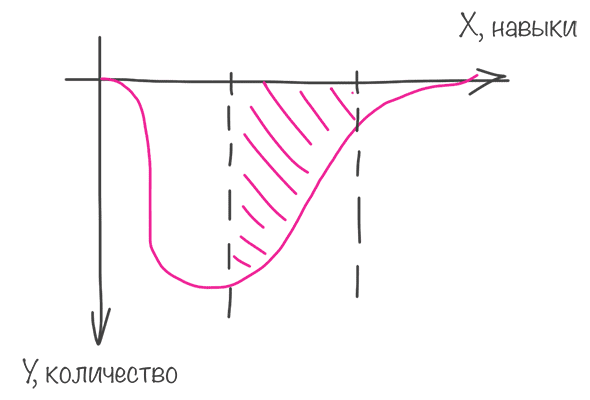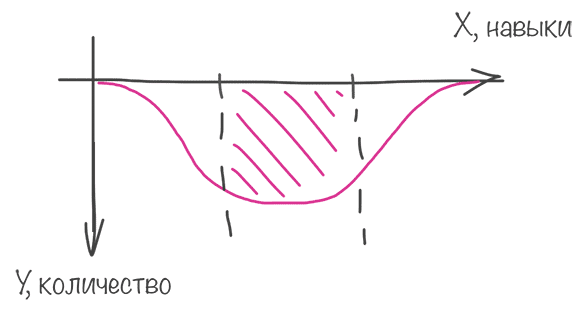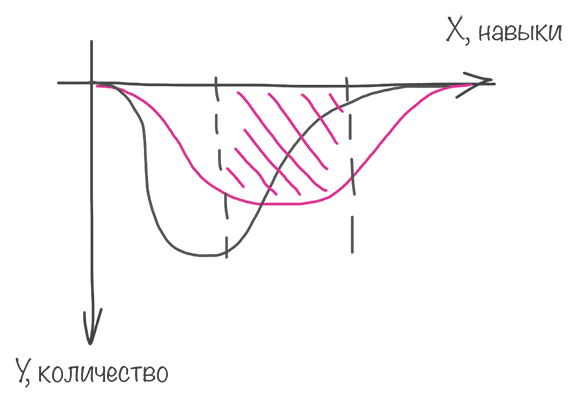Bowl resource - tips on creating a team
A couple of years ago, inspired by a note about Artyom Gorbunov’s “revolutionary time management system” about the philosophy of organizing workflows introduced in a studio of the same name, I was puzzled by the question: how much human resource is needed for a stable work unit?

It will be about the ideas and conclusions I came to while working as a leader. The article will be useful for novice managers and those who are just planning to become one.
')
In the concept implemented in the studio of Artyom Gorbunov, “Resource” as an idea, and “resource” as the main object of study, things are much more multifaceted than the issue I’m talking about. I want to dwell in more detail on human resource.
After all, it’s not for nothing that the guys called the concept “Resource”, knowingly anticipating associations with the Human Resource .
Imagine the situation, a new group / department / project is being formed. Let the starting number of employees be two. What are the roles of these people? Even among two people, there should be a subordination scheme, since one particular should be responsible for the activities of the department. Thus, it turns out that one is a responsible person, and the second is an active one.

Let me explain, the first is not something that would be directly responsible for the fact, he is responsible for the statute / regulations / rules. Those. He is responsible for the activities of the unit, but this does not mean that in all cases he will be 100% responsible. And on the second lies the task, first of all, on directly implementing the tasks of the department. The first, of course, too, must and can do the work with “hands”, but to a much lesser degree.
Two, three, four people are working, the volume of tasks is growing, there is a need to increase the productivity and, if I may say so, the fault tolerance of the department. How will we decide: an increase in the number of employees or an increase in the productivity of current employees, or will we use both? The emergence of such issues is a normal stage of development of any unit.

The answer, as a rule, is working in two directions at once: the number of employees increases and the quality of the skills of employees, both current and new, increases.
For the formation of the department it is necessary to form healthy competition in the department. Such at which conflicts are minimal, the performance is maximum and clearly visible prospects for the growth of the employee concerned. Competition in an equal society is weak by nature - there is no guideline. You can not achieve significant success / development without an example in front (good or bad).

We are not talking about competition between an ordinary specialist and a leading developer, the role of the lead developer is to give an opportunity to develop faster to those who are interested. There is a reverse moment, if the specialist does not strive for development, then he does not need to be forced. We need to find him a comfortable position / role / task. Perhaps this is the value of this employee.
Develop roles in team members. Do not assign, namely develop! The initiative to have one or another role must come from the employee himself, albeit unconsciously.
Analyze which of the employees is engaged in anything other than performing their regular duties.

Roles can be very different, from critic to know-all, the most obvious is Team Lead. Employees of the role will be given the opportunity to understand "with whom you can consult on what matter." And the manager will have another “good” tool for the self-organization of the team.
In addition to the roles, it is possible and necessary to develop in the staff of specialization: any narrow directions, insanely interesting to a specific employee. This skill is from time to time required to apply in the department, but its possession of all team members is not necessary.
And here comes the moment when the department is formed, even if in the minimum configuration, the tasks are carried out, hr'y from time to time offer new candidates.
Looking ahead, I will say that the conclusions I came to may not be appropriate for your model. If your team consists only of professionals, or vice versa - if your model is “worked out” for junior wear, then the scheme is not for you.
I hope that your answer is "an ordinary specialist." A young specialist cannot solve problems at the speed of an ordinary specialist, for a variety of reasons: he learns, he asks many questions, he does not possess the proper professional skills. Higher-level specialists: leading developers, technical leaders, are more often engaged in more global technical issues: architecture, tools, teach juniors, etc.
If otherwise, then, most likely, you have some difficulties in your team - everyone should deal, first of all, with their tasks.
Frankly, I don’t remember where the term “cup” came from, either I read Gorbunov, I read the term, or the term was born, or I thought it up, it doesn’t matter. The main thing is that the term vividly and fairly accurately reflects the concept.
Let's get down to business. Let us agree that the x-axis (x) is the conditional level of training of the specialist, and the y-axis (y) is the conditional number of employees at this level.
Imagine a department in which the majority of employees are juniors. Let's look at the "bowl" reflecting this situation.

We see a very overloaded left side. It is not enough experts - the central part is not filled. This option is the most expensive in terms of management and testing. But cheap in terms of monthly labor costs. As for the total cost of development, it will directly depend on the quality of the code. And the spread here can be significant. The development time with such a scheme is great.

The opposite situation, if the basis of the team are leading experts. It's one thing when the general / average level of an ordinary specialist is high, another is when these specialists occupy high positions within the team / project. There are few specialists in the central part.
Yes, there are teams consisting of only bearded specialists, but in this case, the team should have outrageous motivation for the product / company, etc. There should be a unifying factor that will be above all. This atmosphere is more typical for startups than for established products.
We recall that ordinary specialists do the main real work. Look at the "bowl" in this case.

Please note that the total number of specialists in all graphs is the same. For clarity, we will demonstrate different situations in one image.

The main part of the staff are ordinary specialists. Junior and leading there, but without excess. There is room for juniors to grow, specialists have an environment for development (there is someone to teach, there is someone to learn), the leaders have enough area of responsibility and control.
There may be a situation in which there may be a lot of young professionals; you will not be able to adequately manage a large number of juniors without employees with sufficient management skills. Similarly, there may be many tough developers, they may not have enough tough tasks.
I note that the probability of leaving an employee is maximum precisely at the edges of the bowl: the junior may be tired, understand that “not mine”, or fail the probationary period, and the reason for leaving the presenter may be to reach the limit in development within this project / department / company.
Use and develop!

It will be about the ideas and conclusions I came to while working as a leader. The article will be useful for novice managers and those who are just planning to become one.
')
What are we talking about?
In the concept implemented in the studio of Artyom Gorbunov, “Resource” as an idea, and “resource” as the main object of study, things are much more multifaceted than the issue I’m talking about. I want to dwell in more detail on human resource.
About "Resource" in a nutshell
In the center of the system - the concept of "sludge" and the fight against it. "Sucks" - this is when you come to work at three o'clock in the afternoon and hope to slip unnoticed. Or you are late for the meeting, and one of your colleagues jokes: “Look, who has come!”. Or come up with a cold to not come to work. "Sludge" causes the complex "I work poorly and inefficient," the waste of working energy.
Examples of sludge in working conversations:
“Where are you?” (By phone to a late employee)
“This is Max saying so on the phone”
"This is Tanya, so the letter wrote"
"And I said that it would be so"
“Why are you working again at night?”
“It's good that you joined us” (if late)
"It is not customary to leave at 23:00 on the night before the deadline" (an employee with bruises under his eyes, working from nine in the morning)
Link to note
Examples of sludge in working conversations:
“Where are you?” (By phone to a late employee)
“This is Max saying so on the phone”
"This is Tanya, so the letter wrote"
"And I said that it would be so"
“Why are you working again at night?”
“It's good that you joined us” (if late)
"It is not customary to leave at 23:00 on the night before the deadline" (an employee with bruises under his eyes, working from nine in the morning)
Link to note
Someone will say that these are completely different things, and will be partially right. But in part, because the main object of the above concept is a person / employee.
After all, it’s not for nothing that the guys called the concept “Resource”, knowingly anticipating associations with the Human Resource .
Imagine the situation, a new group / department / project is being formed. Let the starting number of employees be two. What are the roles of these people? Even among two people, there should be a subordination scheme, since one particular should be responsible for the activities of the department. Thus, it turns out that one is a responsible person, and the second is an active one.

Let me explain, the first is not something that would be directly responsible for the fact, he is responsible for the statute / regulations / rules. Those. He is responsible for the activities of the unit, but this does not mean that in all cases he will be 100% responsible. And on the second lies the task, first of all, on directly implementing the tasks of the department. The first, of course, too, must and can do the work with “hands”, but to a much lesser degree.
The formation of units
Two, three, four people are working, the volume of tasks is growing, there is a need to increase the productivity and, if I may say so, the fault tolerance of the department. How will we decide: an increase in the number of employees or an increase in the productivity of current employees, or will we use both? The emergence of such issues is a normal stage of development of any unit.

The answer, as a rule, is working in two directions at once: the number of employees increases and the quality of the skills of employees, both current and new, increases.
So what should be the size of the team? Without whom the team can not do?
For the formation of the department it is necessary to form healthy competition in the department. Such at which conflicts are minimal, the performance is maximum and clearly visible prospects for the growth of the employee concerned. Competition in an equal society is weak by nature - there is no guideline. You can not achieve significant success / development without an example in front (good or bad).

We are not talking about competition between an ordinary specialist and a leading developer, the role of the lead developer is to give an opportunity to develop faster to those who are interested. There is a reverse moment, if the specialist does not strive for development, then he does not need to be forced. We need to find him a comfortable position / role / task. Perhaps this is the value of this employee.
Roles and specialization
Develop roles in team members. Do not assign, namely develop! The initiative to have one or another role must come from the employee himself, albeit unconsciously.
Analyze which of the employees is engaged in anything other than performing their regular duties.

Roles can be very different, from critic to know-all, the most obvious is Team Lead. Employees of the role will be given the opportunity to understand "with whom you can consult on what matter." And the manager will have another “good” tool for the self-organization of the team.
In addition to the roles, it is possible and necessary to develop in the staff of specialization: any narrow directions, insanely interesting to a specific employee. This skill is from time to time required to apply in the department, but its possession of all team members is not necessary.
Quantity or quality?
And here comes the moment when the department is formed, even if in the minimum configuration, the tasks are carried out, hr'y from time to time offer new candidates.
Reasonable questions appear: what employees to look for, how to strengthen the team, how to ensure redundancy, where to find resources for the technical development of the department?
Looking ahead, I will say that the conclusions I came to may not be appropriate for your model. If your team consists only of professionals, or vice versa - if your model is “worked out” for junior wear, then the scheme is not for you.
You analyzed who in your team makes the most of a real product with a previously known quality?
I hope that your answer is "an ordinary specialist." A young specialist cannot solve problems at the speed of an ordinary specialist, for a variety of reasons: he learns, he asks many questions, he does not possess the proper professional skills. Higher-level specialists: leading developers, technical leaders, are more often engaged in more global technical issues: architecture, tools, teach juniors, etc.
And the fact that young and leading experts make a real product less is the norm.
If otherwise, then, most likely, you have some difficulties in your team - everyone should deal, first of all, with their tasks.
The concept of "Chalice"
Frankly, I don’t remember where the term “cup” came from, either I read Gorbunov, I read the term, or the term was born, or I thought it up, it doesn’t matter. The main thing is that the term vividly and fairly accurately reflects the concept.
Let's get down to business. Let us agree that the x-axis (x) is the conditional level of training of the specialist, and the y-axis (y) is the conditional number of employees at this level.
Imagine a department in which the majority of employees are juniors. Let's look at the "bowl" reflecting this situation.

We see a very overloaded left side. It is not enough experts - the central part is not filled. This option is the most expensive in terms of management and testing. But cheap in terms of monthly labor costs. As for the total cost of development, it will directly depend on the quality of the code. And the spread here can be significant. The development time with such a scheme is great.

The opposite situation, if the basis of the team are leading experts. It's one thing when the general / average level of an ordinary specialist is high, another is when these specialists occupy high positions within the team / project. There are few specialists in the central part.
In this situation, the possibilities of vertical growth are severely limited, motivation is falling, and there is a growing discontent of employees, which must be compensated.
Yes, there are teams consisting of only bearded specialists, but in this case, the team should have outrageous motivation for the product / company, etc. There should be a unifying factor that will be above all. This atmosphere is more typical for startups than for established products.
We recall that ordinary specialists do the main real work. Look at the "bowl" in this case.

Please note that the total number of specialists in all graphs is the same. For clarity, we will demonstrate different situations in one image.

The main part of the staff are ordinary specialists. Junior and leading there, but without excess. There is room for juniors to grow, specialists have an environment for development (there is someone to teach, there is someone to learn), the leaders have enough area of responsibility and control.
Appreciate the experts! They are the main force of the division.
There may be a situation in which there may be a lot of young professionals; you will not be able to adequately manage a large number of juniors without employees with sufficient management skills. Similarly, there may be many tough developers, they may not have enough tough tasks.
And many experts with experience in 2-3 years - this is happiness! More than half of the tasks, as a rule, are the current development and support of existing code. And for these tasks your team needs a sufficient number of ordinary specialists.
I note that the probability of leaving an employee is maximum precisely at the edges of the bowl: the junior may be tired, understand that “not mine”, or fail the probationary period, and the reason for leaving the presenter may be to reach the limit in development within this project / department / company.
Use and develop!
Source: https://habr.com/ru/post/296090/
All Articles